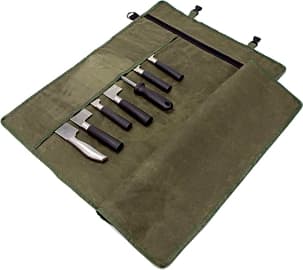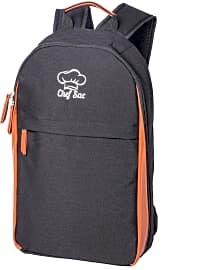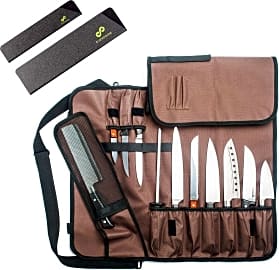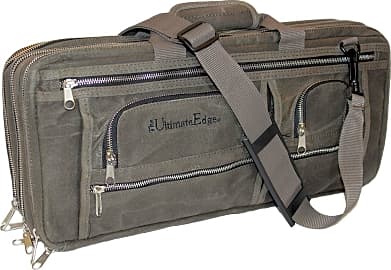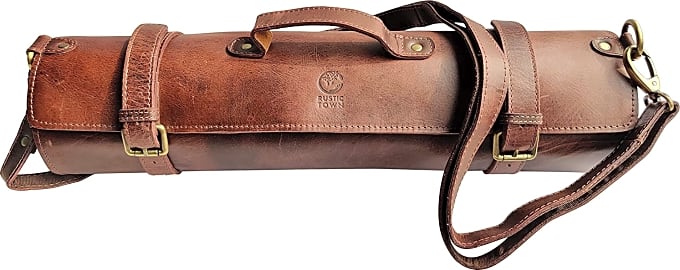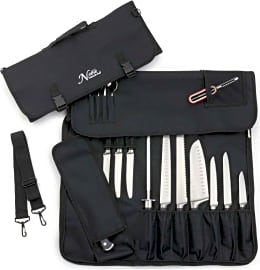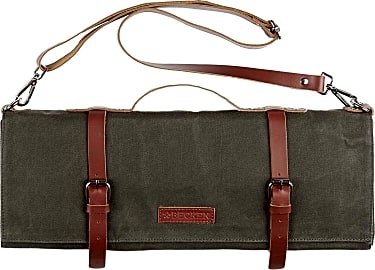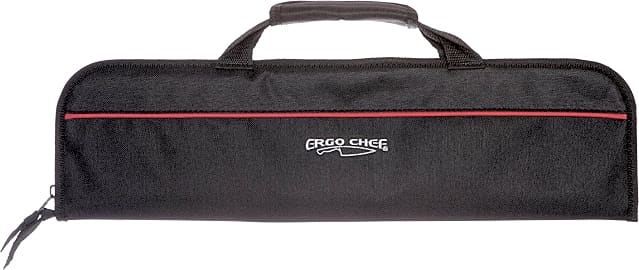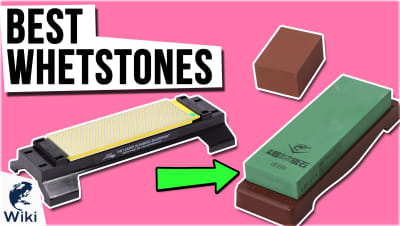The 10 Best Knife Rolls

This wiki has been updated 43 times since it was first published in September of 2015. Serious chefs spend serious money on the tools of their trade. So, if you have expensive equipment you need to keep safe, either at home or when toting it to and from your place of work, check out our selection of protective knife rolls and cases. They come in a variety of styles, colors, and materials, at prices suitable for entry-level cooks as well as collectors of high-end blades. When users buy our independently chosen editorial selections, we may earn commissions to help fund the Wiki.
Editor's Notes
December 01, 2020:
Canvas and nylon are the most common materials for knife rolls, and both have their advantages, but we wanted to ensure that our list included some leather options as well; while it can be a bit trickier to clean and maintain, quality leather is tough, durable, and often quite eye-catching. The Rustic Town Koch is a great example, crafted from sturdy buffalo leather and offering a roomy exterior that makes it less likely for knives to be damaged by colliding when rolled up. Its detachable shoulder strap also makes it easy to carry.
For a slightly higher-end option, we've also added the Hide & Drink Bourbon Brown, an attractive and finely-stitched model with some features that help increase its resistance to moisture. It's replacing the Boldric Black, which we felt was a little too pricey considering its lack of any kind of carrying handle. We also got rid of the Tojiro F-359 in light of a number of reviews indicating its material was a bit too flimsy for holding sharp implements.
Our other new addition is the Chef Sac Backpack, a very practical choice for culinary students, or chefs who get to work by bike or public transit. In addition to its ample space for knives, it's got a number of other useful compartments, including one that can hold a notebook or a slim tablet device.
The cases we've reviewed are great for carrying your blades from place to place, but to keep them organized for everyday use you may want to invest in a block or a magnetic bar. And you'll want to make sure you have a good sharpener to maintain their edge.
December 17, 2019:
If you're a home cook, a worker on a restaurant line, or a true professional chef, you'll benefit from having good knives and keeping them in good shape. Models like the EverPride Roll Bag and Noble Home & Chef KR10 are perfect for budget-conscious users who don't want to sacrifice on storage space, and though they aren't the prettiest options, they work just fine. The Hersent Carrier is notable because while it's affordable enough for beginners, it's actually made of durable canvas at the same price as those made of less-durable nylon. The Ergo Chef 5 Pocket is similarly inexpensive and different from the rest in that it's only designed to hold a few knives, making it perfect for contract chefs who need to always have their primary tools but don't need a full complement of tweezers and mandoline slicers. And while the Tojiro F-359 is another affordable option, its extremely simple nature means it's not quite as versatile as most others. It is, however, an austere and high-quality knife roll that will do justice to high-end Japanese knives.
If you're willing to spend a bit more, you can find something noticeably more stylish and incredibly durable, usually made from nearly waterproof waxed canvas. The Boldric Black is one of these, and like most of the products from Boldric, it's exceptionally well-made and comes highly recommended by professional cooks. The EverPride Professional is made from distressed canvas treated with wax and as such is highly resistant to abrasion as well as stains. As far as attractiveness, durability, and versatility go, though, it's hard to beat the Aaron Leather Mr. Mission Possible.
If you need a ton of space for storing a variety of tools, take a look at the Ultimate Edge 2001-EDB, which is extremely resilient as well as huge. Alternately, some chefs prefer to use an actual tool box, but you'll definitely have to invest in a set of edge guards if you go that route, as high-end knives shouldn't be left to slide around and jostle each other during storage or transport.
Special Honors
Valentich Goods Many chefs agree that Valentich makes some of the nicest knife rolls on the market. They're all made out of premium materials, and in fact, the all-leather varieties are some of the best such models around. They do cost a premium, but they're well worth the price, as they should last almost forever. valentichgoods.com
Jaw Leather Goods The owner of this small company takes his craft very seriously, and crafts every piece with incredible attention to detail. One of his high-end knife rolls is certainly an investment, but he has a surprising range to choose from, and it should basically last for life. jawleathergoods.com
Tom Beckbe Chef’s Designed by a culinary professional, this all-leather bag features nine wide utensil slots on each side, avoiding the lopsided effect that can result from having all your knife hilts at the same end. It has an adjustable shoulder strap with a large pad for comfort, and its interior folds will snap shut to help keep your collection secure. tombeckbe.com
Why You Need A Knife Roll
The cooking novice might wonder why one needs a knife roll and they cannot just stack their knives in a box or briefcase.
A good set of knives is at the top of the list of essential tools every chef needs, but it's also one of the clunkiest and most difficult to carry around. The cooking novice might wonder why one needs a knife roll and they cannot just stack their knives in a box or briefcase. Quality knives can do a lot of damage to one another if they are just thrown into a case, which is why a knife roll, offering separate and secured compartments for each knife, is essential.
Experienced chefs know the importance of a good knife when it comes to almost every element of food from the presentation to consistent cooking, and they cannot count on new and unknown kitchens to have the knives they need. Chefs who need complete control over their cooking environment also like the fact that knife rolls usually have storage compartments for other tools, like zesters and sharpeners, so they don't have to go anywhere without their most trusted accessories.
Knife rolls are made with the properties of good knives in mind. They are constructed of fabric that keeps dust and moisture off of the knives, and have dedicated compartments for the most common sizes and styles of knives to hold them securely in place. Once a chef gets to their destination, they can simply spread out their knife roll and see all of their knives and tools organized in front of them.
Some kitchens might not have space to store an additional set of knives, and some chefs may just prefer not to leave their knives at work where other chefs may potentially damage them. Knife rolls are the ideal way for a chef to transport their knives and other tools to and from work everyday, without having to lug a big and heavy hard case.
The Different Knives And Their Uses
Some knife sets come with as many as 14 knives and other tools, and each one serves its own specific purpose. Familiarizing oneself with each knife can make cooking go faster and help them make food more beautiful. First, there is the chef's knife, which is one of the largest knives in any set. It has a smooth and ultra sharp blade because it's meant to be used to perform a high volume of prep work like chopping carrots, mincing garlic and dicing tomatoes.
One should never try to chop anything with a slicing knife; it has a rather thin blade, and putting too much pressure on it can damage it.
Then there is the bread knife, which will usually have a very long blade that is only about an inch wide, and has a serrated edge. The serrated edge is good for breaking through tough surfaces, like the hard crust of a baguette. This allows the chef to apply less pressure when slicing bread, which is important because applying too much pressure would smash the bread and ruin its shape. Serrated edges are ideal for cutting through any other food with a tough exterior and a soft interior.
Onto the elegant slicing/carving knife. Used to slice cooked meats, it has an extra long blade to allow for cleaner cuts. One should never try to chop anything with a slicing knife; it has a rather thin blade, and putting too much pressure on it can damage it. There are a few essential tricks to cutting raw meat, but no matter the method, one needs a sharp knife. If cutting through meat with bones in it, a cleaver is a must have. These knives rely on their weight to break through the stubborn texture of raw meat and bones.
Cutting Styles Every Chef Should Know
One of the first things beginner chefs will learn in culinary school is basic cutting styles. Most people are already familiar with slicing, but there are a few techniques that can really improve presentation like the julienne. When a vegetable is julienned it is cut into long thin strips. Many recognize the term from recipes like julienne fries, which are long and thinly cut potatoes but there are several theories on where the term comes from. The julienne technique is very popular for making spaghetti squash, but in cases where the ribbons need to be very narrow; a mandoline can make the process go much quicker.
Dicing is another useful cutting style often used on onions.
Dicing is another useful cutting style often used on onions. When dicing a vegetable, it should end up in small cube-like pieces. Diced vegetables add texture to food, and they also cook faster than chopped or sliced ones because they're small and have a large surface area to size ration so they take in heat quicker.
When one wants the flavor of a vegetable but wants its texture to be almost unnoticeable, they mince it. Mincing is the technique of cutting something into the smallest pieces possible. It's common to mince garlic, because people usually want to capture this item's taste, without leaving any noticeable chunks of it in the food. Leafy vegetables like butter lettuce can be too wide to slice, which is why one uses the chiffonade technique. In order to chiffonade something, like basil, the chef must first roll it up and then cut it.


